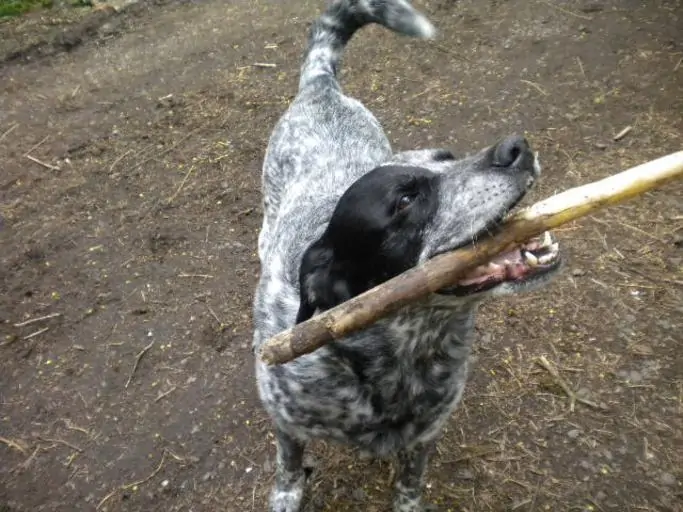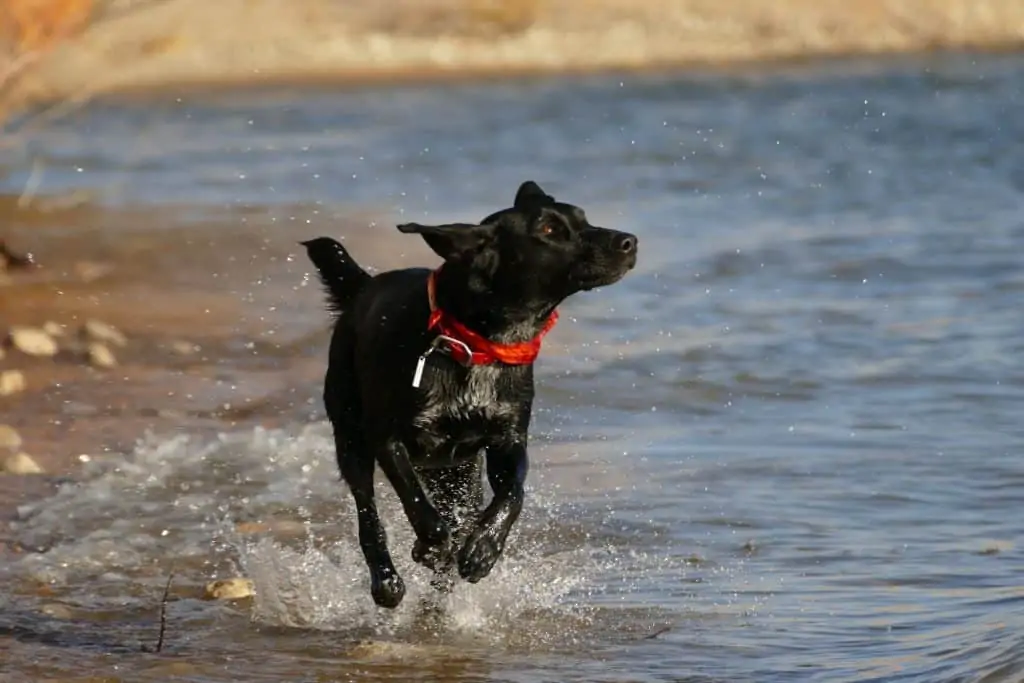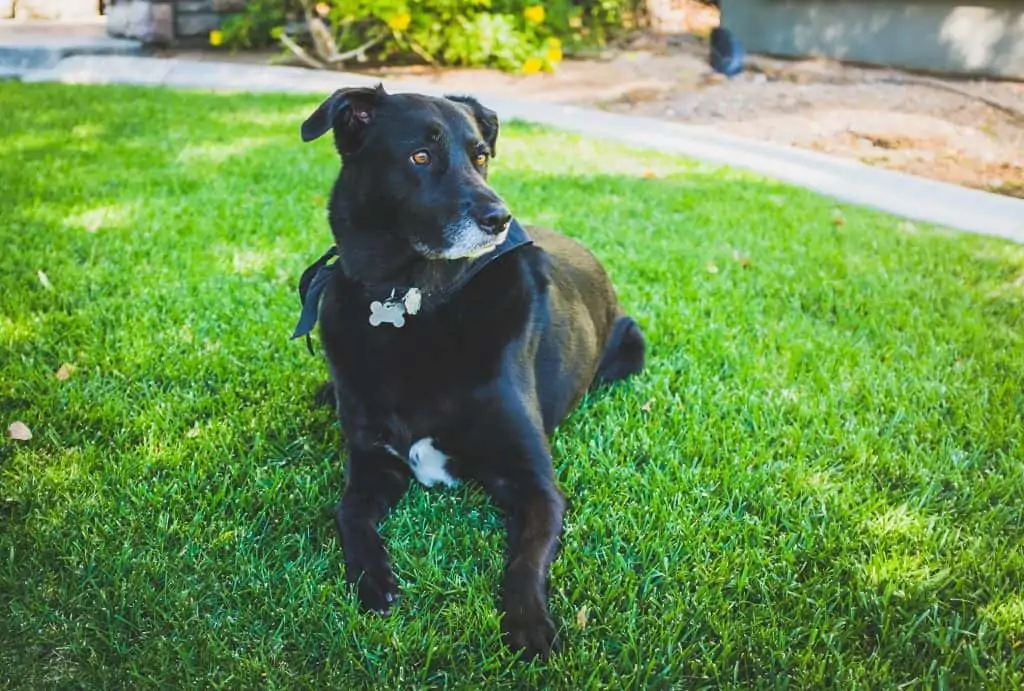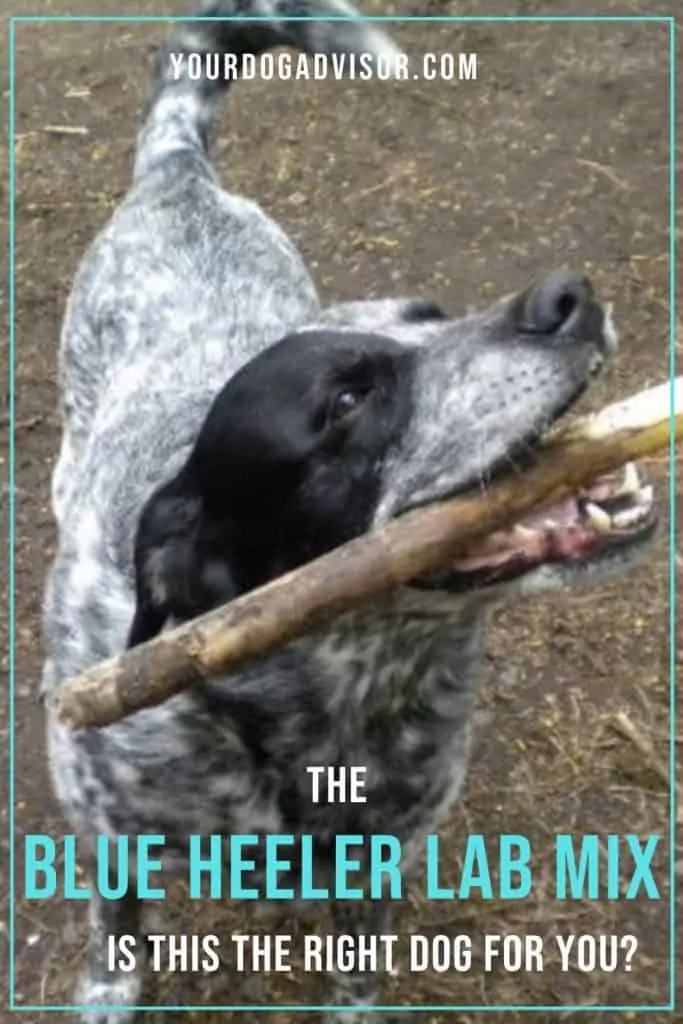Intelligent, versatile, energetic and highly trainable; these are all words used to describe the combination that is the Blue Heeler Lab Mix. A cross between one of the world’s most popular family dogs and one of the world’s most intelligent herding canines, the Blue Heeler Lab mix is certainly a cross to be reckoned with.
But what makes this dog so unique, and which type of household and owner would be best suited to raise a dog with these unique qualities?
That’s what we’re here to discover. Join us today as we learn all about the amazing Blue Heeler Lab mix and find out if this would be the best dog to join your family.
Contents
The Blue Heeler Lab Mix At A Glance
The Blue Heeler Lab Mix is a cross between the Labrador Retriever and the Australian Cattle Dog.
Group: Crossbreed
Parent Breeds: The Blue Heeler (AKA the Australian Cattle Dog) and the Labrador Retriever
Height: 17 to 24.5 Inches
Weight: 35 to 80 Pounds
Temperament: Intelligent, Athletic, Family-Friendly, Energetic
Best Suited For: Active Dog Owners, Committed Dog Owners, Families
Lifespan: 10 to 12 Years
Health Issues: Osteochondritits Dissecans, Deafness, Congenital Portosystemic Shunt, Hereditary Myopathy, Heart Issues, Gastric Dilatation Volvulus, Epilepsy and Lymphoma
Overview Of The Blue Heeler Lab Mix:
The Blue Heeler Lab Mix is a crossbreed dog, which means he is neither a purebred or a mutt. As such, the Blue Heeler Lab Mix is not recognized by most major breed clubs. With that being said, this is a dog that is rising quickly in popularity.
In fact, many families have found that this is an excellent dog with older children and that they enjoy having this intelligent, active and outgoing canine as a part of their family.
With that said, the Blue Heeler Lab Mix does come with its pros and cons, not to mention that there is some controversy surrounding the fact that he is a hybrid.
But what should this mean for you? Keep reading to find out.
Let’s Talk About The Designer Dog Debate
Hybrid dogs are controversial, but they certainly have their pros as well!
Designer dogs are nothing new. Perhaps some of the most famous that you’ll be familiar with include doodle dogs like Labradoodles, Goldendoodles, maltipoos and more. But there are so many other hybrid combinations you may come across, with the Blue Heeler Lab Mix being one of them.
Although humans have been cross breeding dogs for centuries, this is a trend that has hit the mainstream population hard just recently, most notably over the past twenty years.
The problem with newer generation crossbreeds like the Blue Heeler Lab mix is that they are considered less predictable than their purebred counterparts. This is especially true when it comes to traits like health, temperament and physical appearance.
You see, it takes generations of breeding and perfecting before a dog can be considered a purebred. Most dogs were originally crossbreed for working purposes by breeders or enthusiasts taking care to implement responsible breeding practices along the way.
One of the problems with modern-day crossbreeding is that some breeders do it quickly, turning out dogs in an effort to make a quick buck without implementing responsible breeding practices.
This could lead to dogs that develop serious health and behavioral issues down the line.
The good news is that more and more breeders today are taking their jobs very seriously, especially when it comes to breeding crossbreed dogs.
Still, it’s important that you do your research when looking for a crossbreed like the Blue Heeler Lab Mix to ensure you find the healthiest and most responsibly bred dog possible.
And while crossbreeding is a bit controversial, we should also point out that it does have it’s list of pros.
Health, for example, could be one of the most attractive things about a crossbreed dog. One of the downsides of purebred dogs today is that they have been so overbred that their gene pools have dwindled down. This means they are more likely to suffer from some genetic health issues.
Crossbreed dogs, on the other hand, have a widened genepool which can make them less likely to develop certain genetic ailments. This is a theory known as hybrid vigor, and while it’s not accepted by everyone, it is widely accepted by most experts.
On the flip side, crossbreed dogs may also have a longer list of health issues to contend with as they now have two different purebred parents in their DNA.
These are all things you should consider when you are considering investing in a crossbreed dog like the Blue Heeler Lab mix.
And speaking of two purebred parents, it’s time to talk about where the Blue Heeler Lab Mix comes from!
The Origin Of The Blue Heeler Lab Mix
The Blue Heeler in particular is related to the Dingo, which remains one of Australia’s most famous wild dogs.
Because the Blue Heeler Lab Mix is a newer crossbreed to the scene, we can’t tell you exactly where he began. In essence, the Blue Heeler Lab Mix dog’s story is still being written.
The best way to take a dive into the Blue Heeler Lab Mix dog’s history is to look at the backgrounds of his parent breeds.
Let’s begin with the Blue Heeler.
The Blue Heeler
Also known as the Australian Cattle Dog, the Blue Heeler is a highly intelligent canine hailing from Australia. In fact, he is a very unique dog with wild Dingo ancestry.
This combination has made for a clever, rugged and hard-working dog that was ideal for manning the rough terrain of the Australian Outback.
Versatile working dogs, The Blue Heeler is still a famous ranch dog today. He was bred to help drove cattle and livestock for miles on end, as well as protect his territory from predators.
The Blue Heeler also makes a good family dog. He does well with older children when properly raised, trained and socialized and thrives with active, outgoing families.
However, without proper training, socializing and consistent exercise, the Blue Heeler can be problematic in the wrong hands. He can be prone to destructive behaviors and territorial instincts that could lead to aggression if his energy is not harnessed properly.
The Labrador Retriever
The Labrador Retriever has long been a family favorite in the United States. In fact, according to the American Kennel Club, the Labrador Retriever sits at number one out of 197 on the AKC’s list of America’s most popular dog breeds.
Hailing from Newfoundland, Canada, Labradors were once considered a fisherman’s best friend. It was their duty to dive into the chilly Canadian waters and help their masters bring in their catch.
Labs are made for water. They have webbed paws, dense double coats and a unique “otter” tail that helps propel them through currents.
Today, most Labradors have left their fishing work behind in place of being revered family companions. They are still employed as versatile working dogs, however, and are some of the top service dogs in the United States.
If The Blue Heeler Lab Mix Is A Cross Between Two Different Dogs, What Will His Temperament Be Like?
Blue Heeler Lab Mix dogs are friendly, athletic and intelligent.
The Blue Heeler and the Labrador are pretty different dogs with vastly different origins.
However, they are both working dogs at heart, which means it’s safe to say their Blue Heeler Lab Mix offspring will be a focused, work oriented dog as well.
The Blue Heeler Lab Mix is also going to be high energy, athletic, intelligent and family-oriented.
When it comes to family life, the Blue Heeler Lab Mix could be more playful like his Labrador parent or more work-focused like his Blue Heeler parent. There is no real way to tell for sure.
We should note that it’s likely the Blue Heeler Lab mix could have some strong herding instinct, and these instincts could carry over to small children or animals in the home. This could be overwhelming for children and frustrating for parents, so we recommend working with your dog early on to help nip those behaviors in the bud, so to speak.
Like all dogs, the Blue Heeler Lab Mix will need to be properly raised, trained and soclied, especially if he is growing up in homes with children and other pets.
In the right hands, this is a dog that can do well with families and is highly adaptable to a number of living environments so long as his needs are routinely met.
Blue Heeler Lab Mix dogs can be prone to destructive behaviors, unfortunately, and this is especially true if they are not kept physically and mentally stimulated.
We would recommend considering crate training your Blue Heeler Lab Mix and ensuring you do not leave him alone during the day for longer than 5 hours at a time. It’s also important to not leave him without something to keep him occupied and busy.
Exercise And Mental Stimulation For Your Blue Heeler Lab Mix
The Blue Heeler Lab is an energetic dog that requires daily routine exercise.
Hailing from two work-oriented and active parent breeds, it’s no surprise that the Blue Heeler Lab Mix is going to require routine daily exercise. This is a dog that requires at least an hour or so of exercise every day on top of routine free playtime.
Blue Heeler Lab Mix dogs can be quite energetic, especially into their first few years of life. If you’re a laid back person, this may not be the ideal dog for you. Without proper exercise, the Blue Heeler Lab mix can become depressed, anxious and destructive.
The proper exercise for this dog could include a variety of activities such as swimming, hiking, jogging, frisbee, fetch, and free playtime in a securely fenced yard where he can run and play.
If properly socialized and trained, the Blue Heeler Lab Mix could also be a great candidate for dog park days.
When you do walk your Blue Heeler Lab Mix outside, remember that this is an athletic dog. He may be prone to pulling, but we advise against investing in aversive walking equipment like prong collars or choke chains.
Instead, consider a front clip no-pull dog harness, like the Easy Walk Dog Harness listed below.
Easy Walk Front Clip Harness
No products found.
The Easy Walk Front Clip Harness is a dog walking harness specifically designed for active dogs like the Blue Heeler Lab Mix.
Since this harness fits around your dog’s chest and body, it refrains from putting pressure on his throat and chest, which helps rescue his natural instinct to pull.
However, this harness gently redirects your dog back to you if he does get ahead. This is not only much safer and more comfortable for your dog, but it actually helps to teach your dog better walking manners along the way.
Along with investing in the right walking equipment and ensuring your Blue Heeler Lab Mix is properly exercised each day, it’s also important to implement routine and daily mental stimulation.
Remember, the Blue Heeler Lab Mix is a working dog at heart, and he will be happiest when he has a job to do.
Because the Blue Heeler Lab Mix is so smart, you may find that you will be successful in teaching him to help out with routine chores around the home. These chores could include bringing in the mail, sorting the laundry or helping load the dishwasher.
Of course, when you’re gone it is also going to be important to provide your dog with things to do to keep him occupied.
This is where toys like Puzzle Toys and KONGS come into play. KONGS filled with treats can help keep your dog busy and occupied, which can help reduce destructive behaviors.
You can also invest in puzzle toys specifically designed for intelligent dogs like the Blue Heeler Lab Mix.
Because Blue Heeler Lab Mix dogs can be prone to describe behaviors if left alone, you might consider crate training your dog, as we mentioned above.
When done properly, crate training a Blue Heeler Lab MIx can help reduce anxiety and help calm your dog while you are away.
It’s important that you invest in the proper crate for your dog’s specific size and that you work with him early on to help him see the crate as a safe and positive space where he can go to rest and relax.
Midwest ICrate Starter Kit
No products found.
We like the MidWest ICrate because it comes with everything you need when you’re starting out crate training. It includes food and water bowls and even a crate cover to help your dog feel more relaxed inside his crate.
When you are looking for the right crate for your Blue Heeler Lab Mix, remember that you should invest in a crate that is large enough for your dog to stand up, sit down, lay down and turn around in.
It’s also important to make it cozy inside and to never use your dog’s crate as a place of punishment.
Remember, you want your Blue Heeler Lab Mix to love his crate, not fear it.
How To Train And Socialize A Blue Heeler Lab Mix
Blue Heeler Lab Mix dogs are highly trainable and clever.
All dogs require routine training and socialization throughout their lifetime, but training and socialization are especially important for large breed dogs with working tendencies, herding tendencies, and guarding instincts.
The Blue Heeler Lab Mix is a versatile working dog and he may have some or all of these qualities. When harnessed, these can be wonderful assets. However, if not properly trained or socialized, a Blue Heeler Lab Mix can be overwhelming for some.
How To Train A Blue Heeler Lab Mix
It’s never too early to begin training your Blue Heeler Lab Mix. You can and should begin in puppyhood and continue with training throughout your dog’s lifetime.
Try to keep training light, consistent and gamelike. Shorter sessions that are about five minutes in length with plenty of breaks in between have been shown to be most effective. It’s also important to train your Blue Heeler Lab Mix using quality training treats that are small, chewy and very smelly.
Merrick’s Power Bites Training Treats
No products found.
Some of our favorite training treats for dogs are made by Merrick’s. These aptly named power bites are highly palatable for any dog, and they are high-value enough to help keep your dog’s attention during training sessions.
To get the most out of your training treats and to keep them high value, we suggest only pulling these special treats out when it’s time for your dog to really focus.
Avoid negative reinforcement training tactics like scolding, fear or force. This could lead to a breakdown in the bond between you and your Blue Heeler Lab Mix and even hinder his learning progress.
Instead, use positive reinforcement like treats and praise, and work patiently with your dog. You can also implement training, exercise and mental stimulation at the same time. When you do, your Blue Heeler Lab Mix will thrive!
How To Socialize A Blue Heeler Lab Mix
Socializing a Blue Heeler Lab Mix should also begin at an early age, and again this is another part of your dog’s upbringing that should remain consistent throughout his lifetime.
Properly socializing a dog helps to reduce a number of behavioral issues as they grow up including anxiety, depression, fear and even fear based aggression.
To properly socialize a dog, begin during puppyhood by introducing them to a number of new people, places, things and experiences. Help them get used to meeting strangers, other dogs and animals, and being handled by children.
If you do plan on raising your Blue Heeler Lab Mix with children, we also recommend working with children on how to appropriately and gently interact with the family dog. It is always a good idea for the family to learn basic canine body language as well.
Like training, socialization should be consistently carried on throughout your dog’s lifetime. Remember to refrain from forcing your Blue Heeler Lab Mix into situations that are frightening for him, as this could exasperate fears and behavioral issues down the road.
Instead, encourage him gently to explore his world and environment using patience, love and treats.
Tips On Grooming Your Blue Heeler Lab Mix
Blue Heeler Labs are shedding dogs that require routine grooming.
Grooming your Blue Heeler Lab Mix not only helps ensure he is looking his best, but it can also help prevent certain health issues, reduce heavy shedding, and build the bond between you and your dog.
Remember, the Blue Heeler Lab mix is a shedding dog with a dense, weather resistant and double layered coat. This means he will need routine brushing with a deshedding brush, slicker comb and undercoat rake to help collect loose hair, remove any mats, and get rid of build up or debris.
Brushing should be done once a week throughout the year, but perhaps twice a week during shedding season in spring and fall.
Blue Heeler Lab Mix dogs may also be prone to ear infections, so be sure to check your dog’s ears often and keep them clean from waxy buildup, moisture or debris.
Along with routine brushing and ear cleanings, your Blue Heeler Lab Mix should also be bathed once every six weeks. Refrain from overbathing your Blue Heeler Lab Mix or this could cause damage to his skin and coat by stripping them of the natural oils they produce.
It’s also very important that you use a dog safe shampoo specified for canine use.
Natural Dog Company Sensitive Skin Dog Shampoo
No products found.
Using a high quality dog shampoo specified for dogs is important to ensuring your dog’s skin and coat remain healthy. This can also help reduce doggy odor, shedding and buildup of debris.
We like the Natural Dog Company’s Sensitive Skin Dog Shampoo formula because it is made with natural ingredients that will not strip your dog’s coat of the natural oils it produces that protect his skin and fur.
Along with routine bathing every few weeks, make sure to trim your dog’s nails using a dog nail grinder or dog-safe nail trimmer.
If not kept trimmed, your dog’s nails can be prone to splitting and cracking, which can lead to pain and even infection.
Your dog should also have his teeth brushed once a day using a dog safe toothbrush and toothpaste. If toothbrushing proves difficult with your Blue Heeler Lab Mix, then we would recommend investing in some oral wipes or dental chews to help reduce plaque buildup, tartar and prevent gum disease.
What You Should Know About The Blue Heeler Lab Mix Health
The Blue Heeler Lab mix can be prone to the same genetic health issues as his parent breeds.
One of the longest lived dogs in the world was a Blue Heeler dog named Bluey, who lived to be nearly 30 years old.
That said, a dog living this long is very rare, and even designer dogs with hybrid vigor like the Blue Heeler Lab Mix can be prone to suffering from some health issues.
On average, a Blue Heeler Lab Mix has a lifespan of between 1o and 12 years. It’s important to note that he can be susceptible to any of the same genetic health issues as his purebred parent breeds, though he most notably can be prone to suffering from the following ailments:
- Osteochondritits Dissecans
- Deafness
- Congenital Portosystemic Shunt
- Hereditary Myopathy
- Heart Issues
- Gastric Dilatation Volvulus
- Epilepsy
- Obesity
- And Lymphoma
While it can be difficult to accurately predict what your Blue Heeler dog may develop as he ages, you can help combat certain health issues by following a few tips from experts.
Keep Your Dog On A Quality Diet
Diet plays a huge role in your Blue Heeler Lab Mix dog’s overall health and happiness. Because he is a high energy dog, we would recommend a high protein dog food specified for your Blue Heeler Lab’s age, weight and activity level.
Choose dog foods that contain real meat proteins and are a good source of carbs, fatty acids, vitamins, minerals and water.
Avoid dog foods that contain fillers, additives, byproducts, corn, soy, wheat or gluten. Also refrain from overfeeding your Blue Heeler Lab Mix as he can be prone to obesity and dietary upset.
Consider Investing In A Slow Feeder To Combat Bloat
One of the health issues Blue Heeler Lab Mix dogs can be susceptible to is Gastric Dilatation-Volvulus, also known as Bloat. Bloat is a condition that can come on suddenly and is often life threatening.
This condition occurs when your dog eats or drinks too quickly and air gets into his stomach, causing the intestines to flip.
You can help combat bloat by investing in a slow feeder. Also called a puzzle feeder, slow feeders help reduce Bloat by ensuring your dog slows down when he eats.
Schedule Yearly Wellness Checks With Your Vet
Yearly wellness exams can help you and your vet keep track of your dog’s health as he ages. Wellness exams will also help ensure your dog is up to date with vaccines, parasite prevention, and other preventative care that can ensure he lives his longest, healthiest life.
If you’re concerned about how costly medical care might be for a Blue Heeler Lab Mix, you always have the option of investing in pet health insurance.
Consider Having Your Blue Heeler Health Screened
If you do get your Blue Heeler Lab Mix from a reputable breeder, you will likely also be provided with paperwork proving your puppy has been screened and cleared of serious health issues. If not, you always have the option of having your dog health screened yourself.
A canine DNA kit can provide you with plenty of information on your dog regarding any health issues he may be predisposed to. These kits can also provide you with a wealth of other, very interesting information about your Blue Heeler Lab mix.
Keep A Routine When It Comes To Grooming, Exercise, and Mental Stimulation
Last, keep up with a grooming routine, exercise routine and mental stimulation routine with your Blue Heeler Lab Mix. Not only will these routines help ensure your Blue Heeler Lab Mix is physically healthy, but also metnally healthy as well.
So, Is The Blue Heeler Lab Mix The Right Dog For You?
Blue Heeler Lab mix dogs are wonderful companions, but they could be overwhelming for the more laid back dog owner.
The Blue Heeler Lab Mix can certainly make an excellent dog for the right owner or family, but that doesn’t mean he’s right for everyone.
Remember, Blue heeler Lab Mix dogs are high energy dogs that do best in homes with a large, securely fenced backyard where they can run and play freely. They also will need active owners who can dedicate plenty of time to routine exercise and mental stimulation.
Blue Heeler Lab Mix dogs can do well with children, but they may be best suited for families with older children. Otherwise, they could have a tendency to try and herd smaller kiddos around the home, which can be overwhelming.
It’s also important to remember that the Blue Heeler Lab Mix is an intelligent dog that needs plenty of training and early socialization during puppyhood and then throughout his lifetime.
If his needs aren’t met, this is a dog that could be prone to serious destructive behavior and behavioral issues down the road.
So, do you think the Blue Heeler Lab Mix is the right dog for you and your home? Let us know what you think about this amazing mix in the comment section below.


Jen Jones is a professional dog trainer and behavior specialist with more than 25 years of experience. As the founder of ‘Your Dog Advisor’ and the ‘Canine Connection’ rehabilitation center, she applies a holistic, empathetic approach, aiming to address root causes rather than merely treating symptoms.
Well known for her intuitive and compassionate approach, Jen adopts scientifically-proven, reward-based methods, encouraging positive reinforcement over punishment. Jen specializes in obedience training, behavior modification, and puppy socialization. Her innovative methods, particularly in addressing anxiety and aggression issues, have been widely recognized. Jen has worked with many of the world’s leading dog behaviorists and in her free time volunteers with local animal shelters and rescue groups.









